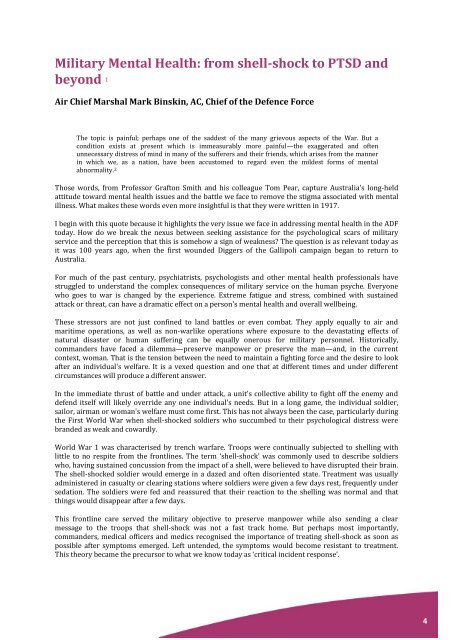Issue No 198 2015
198 2015 Nov_Dec
198 2015 Nov_Dec
Create successful ePaper yourself
Turn your PDF publications into a flip-book with our unique Google optimized e-Paper software.
Military Mental Health: from shell-shock to PTSD and<br />
beyond 1<br />
Air Chief Marshal Mark Binskin, AC, Chief of the Defence Force<br />
The topic is painful; perhaps one of the saddest of the many grievous aspects of the War. But a<br />
condition exists at present which is immeasurably more painful—the exaggerated and often<br />
unnecessary distress of mind in many of the sufferers and their friends, which arises from the manner<br />
in which we, as a nation, have been accustomed to regard even the mildest forms of mental<br />
abnormality. 2<br />
Those words, from Professor Grafton Smith and his colleague Tom Pear, capture Australia's long-held<br />
attitude toward mental health issues and the battle we face to remove the stigma associated with mental<br />
illness. What makes these words even more insightful is that they were written in 1917.<br />
I begin with this quote because it highlights the very issue we face in addressing mental health in the ADF<br />
today. How do we break the nexus between seeking assistance for the psychological scars of military<br />
service and the perception that this is somehow a sign of weakness? The question is as relevant today as<br />
it was 100 years ago, when the first wounded Diggers of the Gallipoli campaign began to return to<br />
Australia.<br />
For much of the past century, psychiatrists, psychologists and other mental health professionals have<br />
struggled to understand the complex consequences of military service on the human psyche. Everyone<br />
who goes to war is changed by the experience. Extreme fatigue and stress, combined with sustained<br />
attack or threat, can have a dramatic effect on a person's mental health and overall wellbeing.<br />
These stressors are not just confined to land battles or even combat. They apply equally to air and<br />
maritime operations, as well as non-warlike operations where exposure to the devastating effects of<br />
natural disaster or human suffering can be equally onerous for military personnel. Historically,<br />
commanders have faced a dilemma—preserve manpower or preserve the man—and, in the current<br />
context, woman. That is the tension between the need to maintain a fighting force and the desire to look<br />
after an individual's welfare. It is a vexed question and one that at different times and under different<br />
circumstances will produce a different answer.<br />
In the immediate thrust of battle and under attack, a unit's collective ability to fight off the enemy and<br />
defend itself will likely override any one individual's needs. But in a long game, the individual soldier,<br />
sailor, airman or woman's welfare must come first. This has not always been the case, particularly during<br />
the First World War when shell-shocked soldiers who succumbed to their psychological distress were<br />
branded as weak and cowardly.<br />
World War 1 was characterised by trench warfare. Troops were continually subjected to shelling with<br />
little to no respite from the frontlines. The term ‘shell-shock’ was commonly used to describe soldiers<br />
who, having sustained concussion from the impact of a shell, were believed to have disrupted their brain.<br />
The shell-shocked soldier would emerge in a dazed and often disoriented state. Treatment was usually<br />
administered in casualty or clearing stations where soldiers were given a few days rest, frequently under<br />
sedation. The soldiers were fed and reassured that their reaction to the shelling was normal and that<br />
things would disappear after a few days.<br />
This frontline care served the military objective to preserve manpower while also sending a clear<br />
message to the troops that shell-shock was not a fast track home. But perhaps most importantly,<br />
commanders, medical officers and medics recognised the importance of treating shell-shock as soon as<br />
possible after symptoms emerged. Left untended, the symptoms would become resistant to treatment.<br />
This theory became the precursor to what we know today as ‘critical incident response’.<br />
4


